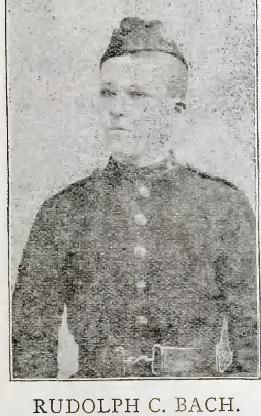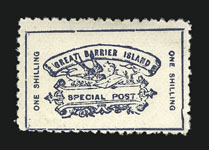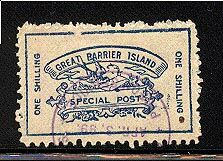 |
|||||
|
|||||
| Preview of Stamps Catalogue: VOLUME 1 |
 |
|||||
|
|||||
| Preview of Stamps Catalogue: VOLUME 1 |
(or Rudolf C.Bach) Stamp dealer and forger of Montreal (Canada)
Return To Catalogue - Canada - Great Barrier Island
Note: on my website many of the
pictures can not be seen! They are of course present in the catalogue;
contact me if you want to purchase it.

Rudolph C.Bach as pictured in his own journal 'The Montreal
Philatelist' Vol. 1, no.1 1898.
Rudolph C.Bach, a stamp dealer in
Montreal, started a philatelic magazine 'The Montreal
Philatelist' in April 1898. It was written partly in German ('The
best German - American Stamp Paper in the World' as stated in his
own journal). According to his own journal, Bach was born in the
1870's in Magdeburg, Germany. He started collecting at the age of
10 and started dealing in 1891. He was a member of the B.Company,
1st Prince of Wales Rifles, Canadian Militia. As such he
volunteered to be sent to the Boer war in 1899. He must have
survived the Boer war, since he was send to WWI according to "The
call to arms: Montreal's roll of honour, European war, 1914" (page 15). However, I have not been able to find any
philatelic 'traces' of him after 1901 (unless he is the same
R.C.Bach who resided in New York, see remarks later).
As a funny detail, in his own journal he asks for 'a Kodak' or
good stamps in exchange for advertising space in the Montreal
Philatelist. Rudolph C.Bach was not re-admitted in his own
journal in 1901.... (Montreal Philatelist Vol.3 No.6 December
1900, p.68) after it was taken over by a certain Mr.Wurtele. He
was most 'famous' for his forgery of the Great Barrier Island,
which caused quite a scandal in Canada at the time (and might
have even been the reason he left for South Africa).

(Genuine stamp, reduced size, image obtained from a Siegel
auction)

(Bach forgery, reduced size)
The aboved stamp is a forgery: circular date stamp Apr.3, 1899, Pigeon Service. The genuine stamp has a line before the letter "G" of "GREAT" and a dot after the word "POST". Rudolph C.Bach made the above forgery of this stamp (another forgery exists; see under Great Barrier Island).
In "The Montreal
Philatelist" (Vol.2 No.5 November 1899, p.6; Editor Rudolph
C.Bach himself!) the following text can be found, together with
an image of what I believe concerns the above forgery:
THE GREAT BARRIER ISLAND STAMPS.
The labels so extensively advertised and sold by the Dominion
Stamp Co.,we regret to say turn out to be undoubtedly
counterfeits. A comparison between these forgeries, and the cut
used as an illustration of the stamp in the catalogues and
Philatelic Journals, reproduced herewith, reveals the fact that
the counterfeits were printed from the same electrotype. There
are many points of difference between them and the original
genuine stamp. The stock remaining has been destroyed and we have
no doubt that upon Mr. Bach's return from the Transvaal war he
will make a satisfactory settlement with all those who purchased
the stamps from him.
Note: the site
http://www.norbyhus.dk/fipliterature/biographies52.PDF states
that the Dominion Stamp Co. belonged to Mr. R. C. Bach and that
he was responsable for these Great Barrier Island forgeries. The
Dominion Stamp Co. advertises with the address 'Beaver Hall Hill,
Montreal', while Rudolph C.Bach has a different address '451
Sanguinet St. Montreal' according to advertisements in his own
journal 'The Montreal Philatelist'.

Advertisement of the Dominion Stamp Co. for the Great Barrier
Island stamps (Montreal Philatelist Vol.2 No.3, 1899, page 13)
Indeed Bach gives away Great
Barrier stamps when customers subscribe to his journal:
'Why not subscribe now. Send us 25 c silver for a years
subscription and we will send you by return mail a copy of the
rare 1 shilling Great Barrier Island Stamp, as premium'.
In 'The Montreal Philatelist'
Vol.2, no. 5, November 1899, page 5 states that the editor of
this journal Mr. R.C.Bach volunteered to be send to the Transvaal
in the Boer war. It says:
'Before leaving he made a transfer of his property viz. The
Dominion Stamp Co. and The Montreal Philatelist to Mr.
F.W.Wurtele, Mgr. giving full power to represent him in all
matters during his absence.'
This clearly proves that the Dominion Stamp Co.
was the property of Bach, despite the different addresses given
above. Mr.Wurtele sold the Dominion Stamp Co., including the
entire stock, to Mr. James Anderson almost immediatly after Bach
went to the Transvaal. Mr. Anderson renamed the business as Mount
Royal Stamp Co. (same address 6 Beaver Hall Hill
Montreal). This text was immediatly followed by the above shown
text concerning the Great Barrier Island stamps.
The Montreal Philatelist (Vol.2,
No 7, January 1900, page 82) says:
'we have no mission to defend the actions of Mr.Bach; we know
much more of his doings than anyone else, and while frankly, we
say that much that he has done appears indefensible and culpable,
we cannot forget, that this young man is now far away, bravely
fighting the battles of his country, and even as we pen these
lines he may have expiated in his heart's blood any faults he has
commited.
The Philatelic Advocate
(Vol. 7, No. 6, p.43; editors Starnaman Bros. Berlin Ontario)
states:
"Great Barrier Forgery.
"Quite a sensation was caused among the philatelists of this
city when it came out that the 'Great Barrier Island Pigeon Post'
stamps(?), with which the country has been flooded, had been
printed, perforated and cancelled in this city. Although there
has always been a strong suspicion that these stamps were not
'all right' it was hardly thought that they were being
manufactured in this city.
The whole scheme was worked by the manager of the late Dominion
Stamp Co. who is now on his way to South Africa with the Canadian
Volunteers.
But this is not all, as it is said that in the same box in which
the stock of Pigeon Post stamps were found, there were several
hundred counterfeit 3 penny Canada which were evidently awaiting
the cancelling stamp." - Montreal Notes in Weekly Era."
The Philatelic Advocate (Vol.8
No.1 January 1900, p. 31) finally says: 'Everyone has now a
stone to sling at Bach, who had better stay to teach the
conquered Boers the beauties of our hobby'.
to continue with a little rhime on page 85:
"'A little Bach
sparrow sat up in a tree
And he was as slick as a sparrow could be.
A philatelist came by with his bow and arrow,
Said he, "I will shoot this little Bach sparrow;
His giblets will make me a nice little stew
His body will make me a little pie too"
Said the little Bach sparrow, "I shall be nabbled if I
stay,"
So he straightway enlisted and sailed away,
For the Boers with their guns had no such terrors for him,
As counterfeit Great Barrier
stamps so grim."
A last trace of Bach appears in
The Montreal Philatelist (Vol.2, No.2, June 1900, p. 145)
concerning forgeries of Uruguay:
URUGUAY - We have been shown a counterfeit of the 1899 5 m.
purple. It can be distinguished from the genuine by the liberty
cap, which is a cap in the genuine stamps, but in the forgery
looks like an Indian head dress. The perforation is also
different being 12 1/2 instead of 11 1/2 Some of these
counterfeits were found in the stock of the Dominion Stamp Co.
(R.C.Bach) and were destroyed, by the trustee, when he came into
possession ; we have since heard that from the same source
considerable quantities were sold last year to New York dealers.
This will be another matter to investigate at the close of the
South African war.
There is a R.C.Bach editing 'The Stamp Collector's Magazine' in the 1920's on Nassau Street (New York). I do not know if this is the same person. Finally, the Islandic journal Heimskringla of 5 October 1932 mentions that a certain Rudolph C.Bach, editor in New York, shot himself......